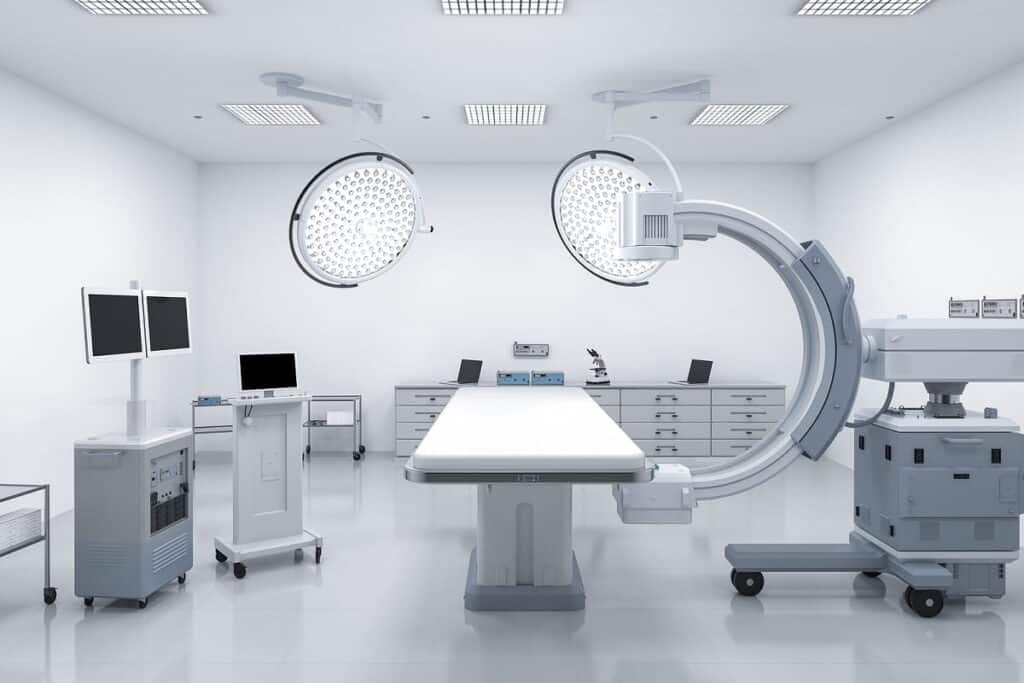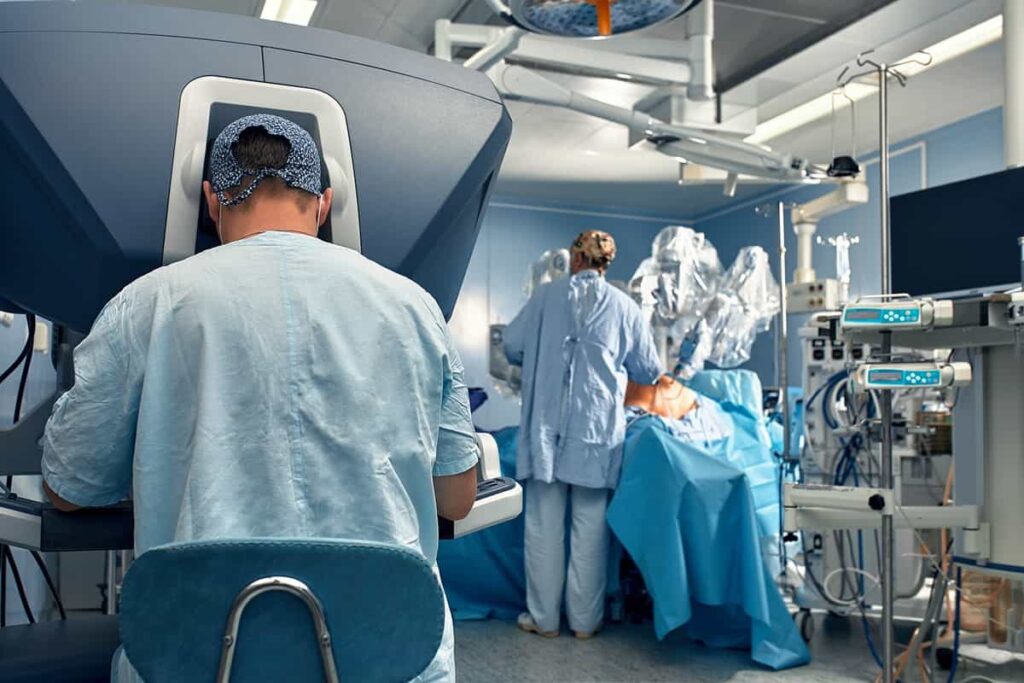Vicarious Surgical Stock – Surgical Robots With VR
Table of contents

“Vicarious Surgical develops virtual reality (VR) software for minimally invasive surgery procedures.” That’s what Crunchbase says today, and that’s what we thought they were doing when we first wrote about the company back in 2017 in a piece titled 15 Virtual Reality Startups in Healthcare. At the time, we didn’t think VR surgeries made much sense. Does a surgeon really need to have a 360-degree field of vision to do a remote surgery? Or can they – as they’re already doing today with robot-assisted surgeries – just view what’s happening on a screen? Turns out we know eff all about what surgeons need, and there are apparently use cases for both.
About Vicarious Surgical
Founded in 2015, Bahstun startup Vicarious Surgical has taken in just over $43 million in funding from investors that include renowned venture capital firm Khosla, Eric Schmidt’s Innovation Endeavors, Marc Benioff of Salesforce, and America’s most eligible bachelor, Sir William of Gates. Vicarious recently announced their intention to go public using a special purpose acquisition company (SPAC) called D8 Holdings (DEH). The offering will raise up to $345 million in cash for Vicarious, and Becton Dickinson (BDX), one of the world’s largest medical device companies, will also join as an investor. The glossy investor deck that accompanies the SPAC offering tells us how Vicarious Surgical plans to disrupt robotic surgeries.
Virtual Reality Surgeries
The evolution of surgical robots – at least according to Vicarious – is one that brings us back at square one. Of the 39 million robotic addressable soft-tissue procedures conducted worldwide each year, half are still open surgery.

The key takeaway is that existing surgical robotics platforms – “legacy robots” as Vicarious calls them – haven’t achieved sufficient product-market fit. That’s where Vicarious steps in with next-generation robotics technology to “solve manual and robot-assisted surgery shortcomings” which are summarized as follows:

Only 3.2% of all surgical procedures today are addressed by legacy robots which cost millions of dollars. Once acquired, roughly 100 procedures are required before a surgeon can become proficient on a legacy surgical robot. The robot-assisted surgery of tomorrow will provide the surgeon with a “360-degree view” that’s enabled by a VR headset along with two robotic arms that are mapped to the surgeon’s own arms.

Each arm has nine degrees of freedom and can enter the body through an incision that’s just 0.6 inches in diameter (existing methods require an incision of a one-inch diameter). While inside the patient, the robot utilizes its 28 sensors on each arm to deftly move around the interior of the patient and avoid creating tertiary injuries. They’ve used technologies like 3D printing to enable lower manufacturing costs, over 5-10x less than traditional manufacturing methods. The sterile part of the device will be disposable, creating an opportunity for high-margin consumables to provide recurring revenues over time.
Vicarious employed some market research firms to query surgeons and administrators who all reacted positively to these features. Studies showed that the robot would be an easy sell, and the device has received breakthrough designation from the FDA. So far, so good.
Just because the company has breakthrough device designation doesn’t mean it’s a gimme. All throughout the deck and management call, the credentials of those steering the ship are stated front and center. It’s to let you know that your money is in capable hands, and the promises being made will be kept. The roadmap shows a beta version this year, a second beta next year, and the first unit built some time in 2023. With 100 units deployed by 2024, revenues then hit that hockey-stick growth that all SPACs promise.

By 2027, they’ll be doing $1 billion in revenues. That’s the plan anyways. Vicarious plans to start by getting 501K clearance for ventral hernia repair, an operation that’s conducted about 900,000 times a year in America alone.
An article by MedTech Dive talks about how many surgeons and hospitals have long-standing relationships with big firms like Johnson & Johnson (JNJ), Intuitive Surgical (ISRG), and Medtronic (MDT), all of whom Vicarious considers competitors. In some cases, existing relationships between these large companies and their customers are contractually forced.
To Buy or Not to Buy
Generating alpha using SPACs used to be so easy even a fool could do it. Buy the SPAC after it debuts, sell a week or so after the announcement. These days that strategy doesn’t work so well. The SPAC that Vicarious plans to merge with, D8 Holdings, is trading at just under $10 a share. If we expect the deal to go through, that’s the price we expect to pay – what institutional investors paid.
Now, here’s another concern. How can we be assured that institutional investors were given a fair valuation to begin with? Retail investors always get the short end of the stick when it comes to SPACs, while the SPAC’s sponsors and the company getting the cash always have their payday. One might argue that participation from Becton Dickinson is a good sign, but how much skin in the game do they really have? Even if Becton Dickinson invested the entire $115 million of the PIPE, that’s still just around 2% of the $5.67 billion in cash they have on hand.
Let’s assume the valuation was fair and you buy management’s vision. You then need to wait a few years to see traction. Vicarious forecasts their first orders to be sometime in 2023. Since we don’t invest in pre-revenue companies, that’s when we’ll take another look – the end of 2023.
Even when Vicarious starts generating revenues, we won’t be jumping all over the stock. That’s because we already have a healthy amount of exposure to medical devices. Our 30-stock dividend growth portfolio holds two of the world’s biggest medical device companies – Stryker (SYK) and Medtronic (MDT) – not to mention Johnson & Johnson (JNJ) which is about 28% exposed to medical devices based on 2020 revenues. We’ve written about how all three of these companies are dabbling in surgical robots:
- Stryker’s Adoption of Robotics and 3D Printing
- Johnson & Johnson (JNJ) and Surgical Robotics
- Medtronic Stock After the Mazor Robotics Acquisition
Collectively, these three companies account for 8.5% of our 30-stock DGI portfolio. If you want low-risk exposure to healthcare technology, buy a basket of the above plus some Becton Dickinson. You’ll have four dividend growth stocks that have been increasing dividends for an average of 44.75 years in a row. In today’s volatile tech stock market, it’s companies like these that help you sleep well at night.
Conclusion
In last year’s piece on 6 Robotic Surgery Stocks for Retail Investors, we learned that not all robotics surgery stocks make for compelling investments, especially ones with no revenues. Demonstrating traction is critically important for many venture capital firms, and the public markets should be no exception. As a famous American philosopher once said, everyone has a plan until they get punched in the mouth. We’ll be on the sidelines rooting for Vicarious, and will revisit the stock in 2023.
If the Vicarious Surgical SPAC transaction closes in Q3-2021 as planned, the ticker will change from DEH to RBOT.
Sign up to our newsletter to get more of our great research delivered straight to your inbox!
Nanalyze Weekly includes useful insights written by our team of underpaid MBAs, research on new disruptive technology stocks flying under the radar, and summaries of our recent research. Always 100% free.
















There is another startup called Vicarious and they are also into robotics and also big in AI, but I think there is no connection between them, even though they have similar names.
BTW: I found your article about Vicarious from 2015: https://nanalyze.com/2015/10/investing-in-artificial-intelligence-ai-with-vicarious/
Good eye, we saw that too. Thank you for pointing this out.